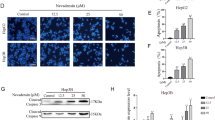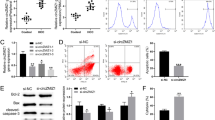Abstract
Hepatocellular carcinoma (HCC) patients have low 5-year survival due to the delayed diagnosis, so it is necessary to develop an alternative treatment. Preferentially expressed antigen of melanoma (PRAME) has a high expression in HCC patients, and the effects of evodiamine on HCC are less characterized, although evodiamine has anti-tumor activities in several tumor types. To investigate the effects of evodiamine on PRAME expression, the in vitro PRAME expression in HepG2 cells after incubated with evodiamine was determined by RT-PCR and western blot. Cell viability, migration, invasion, and apoptosis of evodiamine-incubated HepG2 cells were evaluated by Cell Counting Kit-8, wound healing, transwell assay, and Annexin V-FITC/PI double-staining assay, respectively. To evaluate the mechanism of the regulation of evodiamine on the PRAME expression, chromatin immunoprecipitation coupled with quantitative PCR was employed. Xenograft model was used to evaluate the effects of evodiamine on tumor growth, survival rate, and the PRAME expression. The PRAME expression was inhibited in evodiamine-treated HepG2 cells in vitro and in vivo. The tumor metastasis and growth were inhibited resulting from evodiamine incubation. The evodiamine inhibited the PRAME expression through trimethylation of H3K27. In this study, evodiamine contributes to in vitro and in vivo tumor cell growth inhibition. To achieve this inhibition, the PRAME expression may be repressed through trimethylation resulting from epigenetic regulation of evodiamine.





Similar content being viewed by others
References
Baren V (1998) PRAME, a gene encoding an antigen recognized on a human melanoma by cytolytic T cells, is expressed in acute leukaemia cells. Br J Haematol 102:1376–1379
Barski A, Cuddapah S, Cui K, Roh T-Y, Schones DE, Wang Z, Wei G, Chepelev I, Zhao K (2007) High-resolution profiling of histone methylations in the human genome. Cell 129:823–837
Bray F, Ferlay J, Soerjomataram I, Siegel RL, Torre LA, Jemal A (2018) Global cancer statistics 2018: GLOBOCAN estimates of incidence and mortality worldwide for 36 cancers in 185 countries. CA Cancer J Clin 68:394–424
Bruix J, Gores GJ, Mazzaferro V (2014) Hepatocellular carcinoma: clinical frontiers and perspectives. Gut 63:844–855
Cheung P, Allis CD, Sassone-Corsi P (2000) Signaling to chromatin through histone modifications. Cell 103:263–271
Choi J-Y, Lee J-M, Sirlin CB (2014) CT and MR imaging diagnosis and staging of hepatocellular carcinoma: part II. Extracellular agents, hepatobiliary agents, and ancillary imaging features. Radiology 273:30–50
Duan W, Lopez MJ (2016) Effects of cryopreservation on canine multipotent stromal cells from subcutaneous and infrapatellar adipose tissue. Stem Cell Rev Rep 12:257–268
Epping M, Hart A, Glas A, Krijgsman O, Bernards R (2008) PRAME expression and clinical outcome of breast cancer. Br J Cancer 99:398–403
Fei XF, Wang BX, Li TJ, Si T, Minami M, Xing DJ, Ikejima T (2003) Evodiamine, a constituent of Evodiae Fructus, induces anti-proliferating effects in tumor cells. Cancer Sci 94:92–98
Forner A, Vilana R, Ayuso C, Bianchi L, Solé M, Ayuso JR, Boix L, Sala M, Varela M, Llovet JM (2008) Diagnosis of hepatic nodules 20 mm or smaller in cirrhosis: prospective validation of the noninvasive diagnostic criteria for hepatocellular carcinoma. Hepatology 47:97–104
Gai R, Xu H, Qu X, Wang F, Lou H, Han J, Nakata M, Kokudo N, Sugawara Y, Kuroiwa C (2008) Dynamic of modernizing traditional Chinese medicine and the standards system for its development. Drug Discov Ther 2:2–4
Greer EL, Shi Y (2012) Histone methylation: a dynamic mark in health, disease and inheritance. Nat Rev Genet 13:343–357
Heindryckx F, Colle I, Van Vlierberghe H (2009) Experimental mouse models for hepatocellular carcinoma research. Int J Exp Pathol 90:367–386
Hu Y, Wang S, Wu X, Zhang J, Chen R, Chen M, Wang Y (2013) Chinese herbal medicine-derived compounds for cancer therapy: a focus on hepatocellular carcinoma. J Ethnopharmacol 149:601–612
Ikeda H, Lethé B, Lehmann F, Van Baren N, Baurain J-F, De Smet C, Chambost H, Vitale M, Moretta A, Boon T (1997) Characterization of an antigen that is recognized on a melanoma showing partial HLA loss by CTL expressing an NK inhibitory receptor. Immunity 6:199–208
Jiang J, Hu C (2009) Evodiamine: a novel anti-cancer alkaloid from Evodia rutaecarpa. Molecules 14:1852–1859
Kalogeridi M-A, Zygogianni A, Kyrgias G, Kouvaris J, Chatziioannou S, Kelekis N, Kouloulias V (2015) Role of radiotherapy in the management of hepatocellular carcinoma: a systematic review. World J Hepatol 7:101–112
Kouzarides T (2007) Chromatin modifications and their function. Cell 128:693–705
Lee JG, Kang CM, Park JS, Kim KS, Yoon DS, Choi JS, Lee WJ, Kim BR (2006) The actual five-year survival rate of hepatocellular carcinoma patients after curative resection. Yonsei Med J 47:105–112
Liao C-H, Pan S-L, Guh J-H, Chang Y-L, Pai H-C, Lin C-H, Teng C-M (2005) Antitumor mechanism of evodiamine, a constituent from Chinese herb Evodiae fructus, in human multiple-drug resistant breast cancer NCI/ADR-RES cells in vitro and in vivo. Carcinogenesis 26:968–975
Maluccio M, Covey A (2012) Recent progress in understanding, diagnosing, and treating hepatocellular carcinoma. CA Cancer J Clin 62:394–399
Oberthuer A, Hero B, Spitz R, Berthold F, Fischer M (2004) The tumor-associated antigen PRAME is universally expressed in high-stage neuroblastoma and associated with poor outcome. Clin Cancer Res 10:4307–4313
Ogasawara M, Matsubara T, Suzuki H (2001) Screening of natural compounds for inhibitory activity on colon cancer cell migration. Biol Pharm Bull 24:720–723
Oyama K, Kanki K, Shimizu H, Kono Y, Azumi J, Toriguchi K, Hatano E, Shiota G (2016) Impact of preferentially expressed antigen of melanoma on the prognosis of hepatocellular carcinoma. Gastrointest Tumors 3:128–135
Pernille Tveden-Nyborg TKB, Lykkesfeldt J (2018) Basic & Clinical Pharmacology & Toxicology policy for experimental and clinical studies. Basic Clin Pharmacol Toxicol 123:233–235
Pham T, Todo T, Gish R, Concepcion W (2016) Surgical treatment of hepatocellular carcinoma: resection versus transplantation. Difficult decisions in hepatobiliary and pancreatic surgery. Springer, pp 73–84
Piunti A, Hashizume R, Morgan MA, Bartom ET, Horbinski CM, Marshall SA, Rendleman EJ, Ma Q, Y-h T, Woodfin AR (2017) Therapeutic targeting of polycomb and BET bromodomain proteins in diffuse intrinsic pontine gliomas. Nat Med 23:493–500
Qi F, Li A, Inagaki Y, Gao J, Li J, Kokudo N, Li X-K, Tang W (2010) Chinese herbal medicines as adjuvant treatment during chemo or radio-therapy for cancer. Biosci Trends 4
Steeg PS (2006) Tumor metastasis: mechanistic insights and clinical challenges. Nat Med 12:895–904
Strahl BD, Allis CD (2000) The language of covalent histone modifications. Nature 403:41–45
Tan M, Luo H, Lee S, Jin F, Yang JS, Montellier E, Buchou T, Cheng Z, Rousseaux S, Rajagopal N (2011) Identification of 67 histone marks and histone lysine crotonylation as a new type of histone modification. Cell 146:1016–1028
Tan P, Zou C, Yong B, Han J, Zhang L, Su Q, Yin J, Wang J, Huang G, Peng T (2012) Expression and prognostic relevance of PRAME in primary osteosarcoma. Biochem Biophys Res Commun 419:801–808
Tanaka N, Wang Y-H, Shiseki M, Takanashi M, Motoji T (2011) Inhibition of PRAME expression causes cell cycle arrest and apoptosis in leukemic cells. Leuk Res 35:1219–1225
Tie F, Banerjee R, Stratton CA, Prasad-Sinha J, Stepanik V, Zlobin A, Diaz MO, Scacheri PC, Harte PJ (2009) CBP-mediated acetylation of histone H3 lysine 27 antagonizes Drosophila Polycomb silencing. Development 136:3131–3141
Urruticoechea A, Alemany R, Balart J, Villanueva A, Viñals F, Capella G (2010) Recent advances in cancer therapy: an overview. Curr Pharm Des 16:3–10
Wong R, Sagar C, Sagar S (2001) Integration of Chinese medicine into supportive cancer care: a modern role for an ancient tradition. Cancer Treat Rev 27:235–246
Xu J, Zhu X, Wu L, Yang R, Yang Z, Wang Q, Wu F (2012) Micro RNA-122 suppresses cell proliferation and induces cell apoptosis in hepatocellular carcinoma by directly targeting Wnt/β-catenin pathway. Liver Int 32:752–760
Zhang Y, Wu L-J, Tashiro S-i, Onodera S, Ikejima T (2004) Evodiamine induces tumor cell death through different pathways: apoptosis and necrosis. Acta Pharmacol Sin 25:83–89
Zhang H, Luo H, Hu Z, Peng J, Jiang Z, Song T, Wu B, Yue J, Zhou R, Xie R (2015) Targeting WISP1 to sensitize esophageal squamous cell carcinoma to irradiation. Oncotarget 6:6218
Zhou P, Li X-P, Jiang R, Chen Y, Lv X-T, Guo X-X, Tian K, Yuan D-Z, Lv Y-W, Ran J-H (2019) Evodiamine inhibits migration and invasion by Sirt1-mediated post-translational modulations in colorectal cancer. Anti-Cancer Drugs 30:611–617
Zhu H, Wang J, Yin J, Lu B, Yang Q, Wan Y, Jia C (2018) Downregulation of PRAME suppresses proliferation and promotes apoptosis in hepatocellular carcinoma through the activation of P53 mediated pathway. Cell Physiol Biochem 45:1121–1135
Author contribution statement
Hanzhang Zhu conceived and designed the research. Ke Ge and Jun Lu analyzed the data. Changku Jia wrote the manuscript. All authors read and approved the manuscript.
Funding
The study was supported by the Zhejiang Traditional Chinese Medicine Science and Technology Plan Project (2018ZA081).
Author information
Authors and Affiliations
Corresponding author
Ethics declarations
All procedures were approved by the Institutional Research Ethics Committee of Hangzhou First People’s Hospital.
Conflict of interest
The authors declare that there is no conflict of interests.
Additional information
Publisher’s note
Springer Nature remains neutral with regard to jurisdictional claims in published maps and institutional affiliations.
Rights and permissions
About this article
Cite this article
Zhu, H., Ge, K., Lu, J. et al. Growth inhibitor of human hepatic carcinoma HepG2 cells by evodiamine is associated with downregulation of PRAME. Naunyn-Schmiedeberg's Arch Pharmacol 392, 1551–1560 (2019). https://doi.org/10.1007/s00210-019-01701-7
Received:
Accepted:
Published:
Issue Date:
DOI: https://doi.org/10.1007/s00210-019-01701-7




